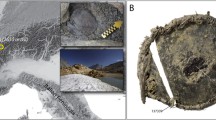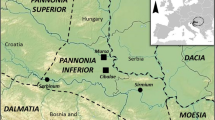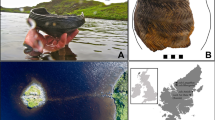Abstract
Despite the abundance of barley in the archaeobotanical record at Roman military sites along Hadrian’s Wall in northern England, and the suitability of the British climate for growing the grain, contention still remains concerning the human consumption of this cereal in the Roman world. Previous experimental and archaeological work has demonstrated that cereal bran fragments in faecal material can be successfully assigned to species. Here, microscopic analysis of plant fragments is utilised to investigate the relative abundance of Triticum/Secale (wheat/rye), Hordeum (barley) and Avena (oats) from faecal deposits from two Roman military sites and a contemporary civilian settlement in Carlisle. Cereal bran was identified in all deposits, along with certain other edible plant fragments such as Coriandrum sativum (coriander) and Allium sp. (onion genus). The presence of barley in deposits from military sites appears to confirm its consumption, with the frequency and size of fragments hinting at likely occasional culinary use in soups and stews. Increased frequency at the contemporary civilian site indicates more widespread culinary use in non-military settlements. The practical and analytical limitations of this method are discussed.









Similar content being viewed by others
References
Bakels C, Jacomet S (2003) Access to luxury foods in central Europe during the Roman period: the archaeobotanical evidence. In: Van der Veen M (ed) Luxury foods. World Archaeol 34:542–557
Bidwell PT (1997) Roman forts in Britain. Batsford/English Heritage, London
Cool H (2006) Eating and drinking in Roman Britain. Cambridge University Press, Cambridge
Dark P (1999) Pollen evidence for the environment of Roman Britain. Britannia 30:247–272
Davies RW (1971) The Roman military diet. Britannia 2:122–142
Dickson JH (1973) Bryophytes of the Pleistocene. Cambridge University Press, Cambridge
Dickson CA (1987) The identification of cereals from ancient bran fragments. Circaea 4:95–103
Dickson CA (1989) The Roman army diet in Britain and Germany. In: Körber-Grohne U (ed) Archäobotanik. J Cramer, Berlin-Stuttgart, pp 135–154
Dickson JH, Dickson CA (1979) Flour or bread in a Roman military ditch at Bearsden, Scotland. Antiquity 53:47–51
Dickson CA, Dickson JH (1988) The diet of the Roman army in deforested central Scotland. Plants Today 1:121–126
Dumayne L (1994) The effect of the Roman occupation on the environment of Hadrian’s Wall: a pollen diagram from Fozy Moss, Northumbria. Britannia 25:217–224
Edwards HJ (1917) (trans) Caesar. The Gallic War. Harvard University Press, Cambridge, MA
Esau K (1965) Plant anatomy, 2nd edn. Wiley, London
Fielding WL, Parkinson ST (1929) Photography as a help in the examination of cattle feeds. J South East Agric Coll, Wye, Kent 26:47–86
Firbank LG (1988) Agrostemma githago (Lychnis githago (L.) Scop.). J Ecol 76:1232–1246
Greig JRA (1981) The investigation of a medieval barrel-latrine from Worcester. J Archaeol Sci 8:265–282
Greig JRA, Girling MA, Skidmore P (1982) The plant and insect remains. In: Barker P, Higham R (eds) Hen Domen, Montgomery, a timber castle on the Welsh border. Royal Archaeological Institute, London, pp 60–71
Hall AR, Huntley JP (2007) A review of macrofossil plant remains from archaeological deposits in northern England. English Heritage Research Department Report Series 87
Hall AR, Jones AKG, Kenward HK (1983a) Cereal bran and human faecal remains from archaeological deposits—some preliminary observations. In: Proudfoot B (ed) Site, environment and economy (British Archaeological Reports, International Series 173). BAR, Oxford, pp 85–105
Hall AR, Kenward HK, Williams D, Greig JRA (1983b) Environment and living conditions at two Anglo-Scandinavian Sites (The Archaeology of York 14/4). Council for British Archaeology, London
Hellwig M (1989) Botanischer Beitrag zur Funktionsanalyse an mittelalterlichen Feuchtsedimenten aus Braunschweig. Nachr Nieders Urgesch 58:267–271
Hellwig M (1997) Plant remains from two cesspits (15th and 16th century) and a pond (13th century) from Göttingen, southern Lower Saxony, Germany. Veget Hist Archaeobot 6:105–116
Holden TG (2001) Dietary evidence from the coprolites and intestinal contents of ancient humans. In: Brothwell DR, Pollard AM (eds) Dietary evidence from the coprolites and intestinal contents of ancient humans. Wiley, Chichester, pp 403–415
Huntley JP (1991) Macrobotanical remains from the Roman fort of Banna (Birdoswald, Cumbria). Ancient Monuments Laboratory Report 104
Huntley JP (1992) Plant remains from excavations at The Lanes, Carlisle, Cumbria: Part 1—CAL, OGL, OBL, and LEL. Ancient Monuments Laboratory Report 51
Huntley JP (1997) Macrobotanical evidence from the horrea. In: Wilmott T (ed) Birdoswald: excavations of a Roman fort on Hadrian’s Wall and its successor settlement 1987–92. English Heritage, London, pp 141–142
Huntley JP (2002) The plant remains. In: Wilson PR (ed) Cataractonium. Roman Catterick and its hinterland. Excavations and research, 1958–1997. Council for British Archaeology, New York, pp 439–445
Huntley JP, Stallibrass SM (1995) Plant and vertebrate remains from archaeological sites in northern England: data reviews and future directions. Architectural and Archaeological Society of Durham and Northumberland, Research Report 4
Jarrett MG (1994) Non-legionary troops in Roman Britain: part one, the units. Britannia 25:35–77
Jones GEM (1998) Distinguishing food from fodder in the archaeobotanical record. Environ Archaeol 1:95–99
Kenward HK, Hall AR (1995) Biological evidence from Anglo-Scandinavian deposits at 16–22 Coppergate (The Archaeology of York 14/7). Council for British Archaeology, York
Kenward HK, Hall AR (1997) Enhancing bioarchaeological interpretation using indicator groups: stable manure as a paradigm. J Archaeol Sci 24:663–673
Knights BA, Dickson CA, Dickson JH, Breeze DJ (1983) Evidence concerning the Roman military diet at Bearsden, Scotland, in the 2nd century A.D. J Archaeol Sci 10:139–152
Knörzer KH (1991) Koproanalyse, ein neuer Beitrag zur Geschichte der Ernährung. In: Renfrew J (ed) New light on early farming; recent developments in palaeoethnobotany. Edinburgh University Press, Edinburgh, pp 39–50
Körber-Grohne U (1964) Bestimmungsschlüssel für subfossile Juncus-Samen und Gramineen-Früchte. Probl Küstenforsch Südl Nordeegebiet 7:1–47
Körber-Grohne U (1991) Bestimmungsschlüssel für subfossile Juncus-Samen und Gramineen-Früchte. Probl Küstenforsch Südl Nordseegebiet 18:169–234
Körber-Grohne U, Piening U (1980) Microstructure of the surfaces of carbonized and non-carbonized grains of cereal observed in scanning electron and light microscopes as an additional aid in determining historical findings. Flora 170:189–228
Kuijper WJ, Turner H (1992) Diet of a Roman centurion at Alphen aan den Rijn, The Netherlands, in the first century A.D. Rev Palaeobot Palynol 73:187–204
Langhorne J, Langhorne W (1898) (trans) Plutarch. Lives. Routledge, London
Livarda A, Van der Veen M (2008) Social access and dispersal of condiments in north-west Europe from the Roman to the medieval period. Veget Hist Archaeobot 17(Suppl 1):201–210
Milner NP (1993) (trans) Vegetius Renatus. Epitome of military science. Liverpool University Press, Liverpool
Rackham H (1971) (trans) Pliny the Elder. Natural history, Libri 17-19, vol 5. Harvard University Press, Cambridge, MA
Renfrew JM (1973) Palaeoethnobotany: the prehistoric food plants of the Near East and Europe. Routledge, London
Seaward MRD, Williams D (1976) An interpretation of mosses found in recent archaeological excavations. J Archaeol Sci 3:173–177
Shuckburgh ES (1889) (trans) Polybius. The histories. Macmillan, London
Stace C (1997) New flora of the British Isles, 2nd edn. Cambridge University Press, Cambridge
Stallibrass S, Thomas R (eds) (2008) Feeding the Roman army: the archaeology of production and supply in NW Europe. Oxbow, Oxford
Tomlinson PR (1991) Vegetative plant remains from waterlogged deposits identified at York. In: Renfrew JM (ed) New light on early farming. Edinburgh University Press, Edinburgh, pp 109–119
Van der Veen M (1989) Charred grain assemblages from Roman-period corn driers in Britain. Archaeol J 146:302–319
Van der Veen M (1992) Crop husbandry regimes: an archaeobotanical study of farming in northern England 1000 B.C.–A.D. 500 (Sheffield Archaeol Monographs 3). Collis, Sheffield
Van der Veen M, Livarda A, Hill A (2008) New food plants in Roman Britain—dispersal and social access. Environ Archaeol 13:11–36
Vindolanda tablets online (2009). http://vindolanda.csad.ox.ac.uk/. Accessed 28 Sept 2009
Wilmott T (2001) Birdoswald Roman fort. 1800 years on Hadrian’s Wall. Tempus, Stroud
Wilson DG (1978) Horse dung from Roman Lancaster: a botanical report. Archaeophysika 8:331–350
Winton AL, Winton KB (1932) The structure and composition of foods, cereal, starch, oilseeds, nuts, oils, forage plants. Chapman and Hall, London
Acknowledgements
Research for this paper was completed in partial fulfilment of the requirements for the degree of Archaeology B.Sc. at the University of Durham by KB. Samples were provided by Durham Archaeological Services, Durham University and Oxford Archaeology. Thanks to Elizabeth Huckerby (Oxford Archaeology), Louisa Gidney and Charlotte O’Brien (Durham), Petra Dark (Reading) and also to Mike Church (Durham), Alex Brown (Reading) and two anonymous reviewers for comments and Stefanie Jacomet (Basel) for editorial critique. Thanks also to the Max Planck Institute for Evolutionary Anthropology, Mike Richards and Jean-Jacques Hublin (MPI-EVA) and to the Natural Environment Research Council and Deutscher Akademischer Austausch Dienst for professional and financial support during the preparation of this manuscript.
Author information
Authors and Affiliations
Corresponding author
Additional information
Communicated by S. Jacomet.
Rights and permissions
About this article
Cite this article
Britton, K., Huntley, J. New evidence for the consumption of barley at Romano-British military and civilian sites, from the analysis of cereal bran fragments in faecal material. Veget Hist Archaeobot 20, 41–52 (2011). https://doi.org/10.1007/s00334-010-0245-3
Received:
Accepted:
Published:
Issue Date:
DOI: https://doi.org/10.1007/s00334-010-0245-3




